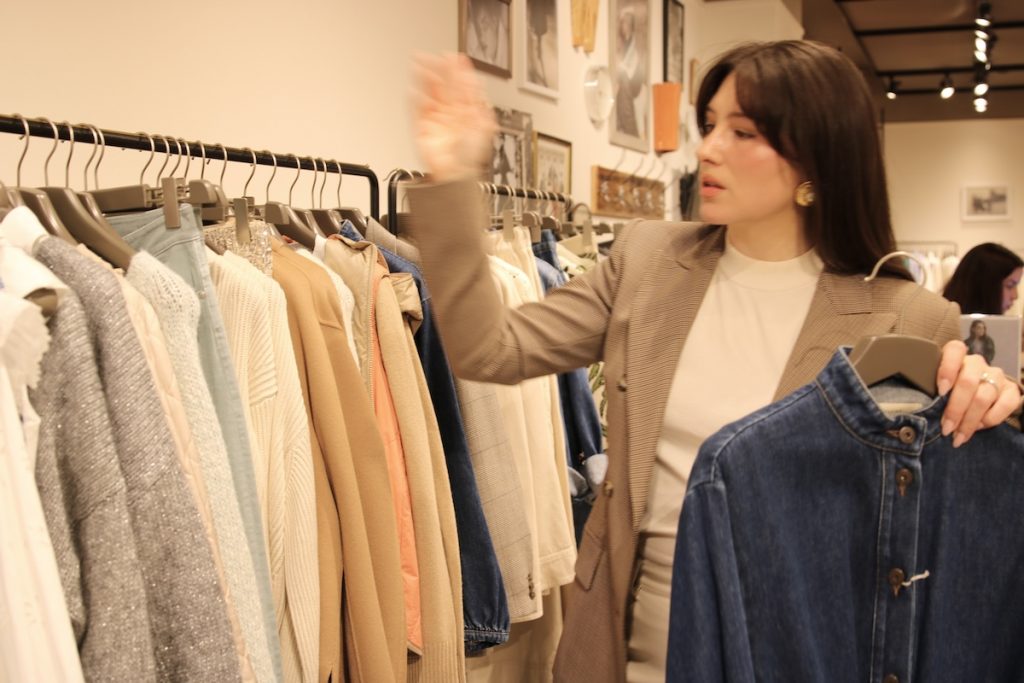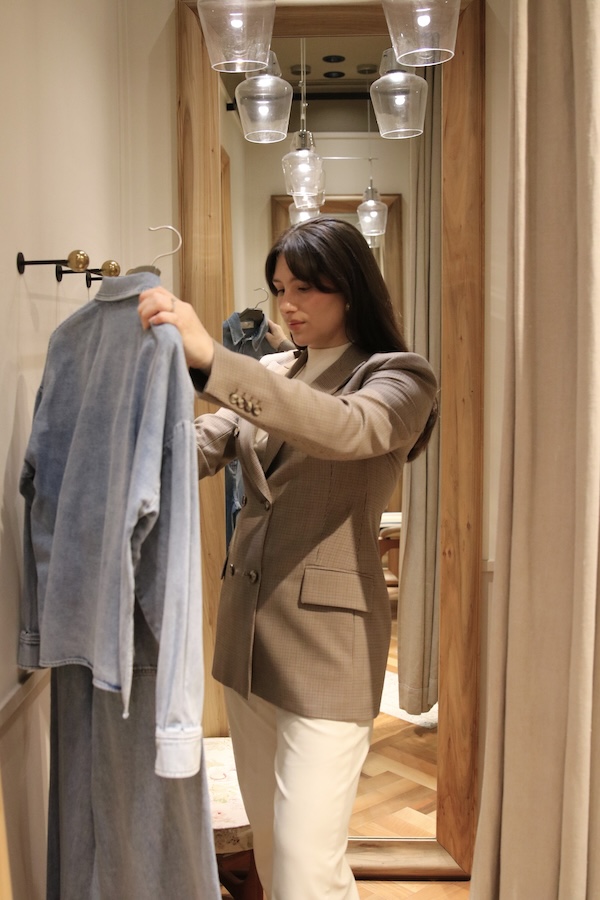
Getting to combine styling, buying, fashion marketing, and retail management for a luxury fashion brand—and getting paid to do it—is a dream career for anyone who wants to work in fashion. Our featured guest, Harriet Guadagnuolo, also known as Hattie, does just that as the Vice President of Retail and Head of Styling and Marketing for Vestis Fashion Group, who oversees all operations for the luxury fashion brand, Max Mara, in Western Canada. She’s also the head buyer, retail VP, and head of marketing for the newly opened Max and Co. and Marella stores in Vancouver.
We caught up with Hattie as she walked us through her typical day and lessons learned along the way. Let’s dive in!
✨ Want to know how to actually break into fashion, succeed as a buyer, and build your skillset for luxury retail marketing? Some of the juiciest, most career-changing parts of this interview are available exclusively to our paid Substack subscribers.
👉 Join Style Nine to Five: The Fashion Career Edit to access the full feature.

Inside a Day as a Fashion VP, Buyer, and Stylist
We learned from Hattie that no two days are the same when you work in fashion. “If you don’t want to be bored, go into fashion,” she says. She took us through what her job entails and how her days look as a head buyer, retail VP, and head of marketing for the Max and Co. and Marella stores.
“My typical day right now is a little bit insane because I have two toddlers. I’m usually up at around 5:15, because I have quite a bit to organize in the morning before I’m out the door. I like to get myself ready for the day before they’re even up so that I have time for myself. I’ve found that that means I’m waking up earlier, because I’ve got to make sure I have time for my girls, but for me, my morning is about presenting myself in a certain way.
A lot of my morning is about getting myself ready for what I’m about to do for the day. I might be seeing clients and having meetings, and I want to make sure that I am representing the brand I’m wearing. For me, that means something trendy and intentional. I use that phrase a lot—intentional dressing.
You are the authority on what’s trending and what’s going on. And so you kind of have to make sure that you represent and embody those characteristics. Some people see fashion as this fickle, flighty, fun industry, and it is fun, of course, but how you put yourself together is a really powerful tool that you can use in your toolbox. To create success in your career is to present yourself in a certain way.”
As far as her job duties go, Hattie explains that there’s never a dull moment in the fashion industry and no two days are exactly alike.
“It changes on any given day depending on where I need to be and what I need to be doing, based on the seasonal cycle. Every day, there is going to be something different going on just by virtue of our calendar.
My role encompasses retail/sales, marketing, and product, so I get to be a part of a lot of different client-facing touchpoints of the business. The fashion industry is very cyclical, so my role follows that cycle. With that, every day is a little bit different; it really depends on what part of the seasonal cycle we are in. Some weeks, I focus more on product, and I lean into my buying role during the buying market, which is a very busy, high-paced, and exciting time to see what’s coming down the fashion pipeline.
From a marketing perspective, I meet with our retail leaders and marketing team to plan and execute our in-store events and promotions for the upcoming season. I’m also a stylist myself, so some days I take clients in-store for wardrobe refreshes, where I style them head to toe with multiple looks for different occasions.”
The Best (and Hardest) Parts of Working in Fashion
If you’re a fashion lover, a career in the industry can be endlessly rewarding for many reasons. Hattie’s favorite thing about her job? She shares the highlights and interactions that make all the hard work worthwhile.
“I love being on the ground in our stores and seeing our product come to life. To be a successful buyer, I think it’s crucial to understand the client and get on their level. I love to style women in our products because I love to help them look and feel their best. Seeing our clients walk out the door with a little more confidence in their steps is something that makes the job fun and rewarding. At the end of the day, these interactions help me get to know our team and our product and help me do my job better, staying close to our front lines.”
The perks don’t come without challenges, though. Once you get your foot in the door, being part of the fashion industry requires a willingness to continually learn and the stamina to keep up with the quick pace. Hattie shares some of the tough parts of being a luxury fashion buyer and how to master the trickier aspects of the job.
“If you want to be a buyer, you need to learn how to be a quick decision-maker. You are making fast decisions and thousands of them a day in a high-pressure environment, considering multiple factors. This has certainly been a learning curve, but one that I have improved with my years of maturity in this industry.
Sometimes you fall in love with garments, but you realize they aren’t for your market, so you can’t buy into them. Other times, you personally could not envision yourself wearing something, but you know your clients will resonate with it. You have to remove yourself from the decision process while using your own judgment, and it’s definitely a challenge sometimes.”
Keeping Up With the Fashion Cycle
The fashion industry is known for its fast pace, rapidly moving from season to season and switching gears between multiple stages throughout the day. Hattie shares how quickly things move in her world and how keeping up with the pace is part of the job.
“The timeframes and the windows are the biggest component of the high-pressure kind of decision-making process. Fashion is cyclical, and you have your seasonal products that come out six to nine months prior to those products releasing in stores. You have what’s called the product market or the buying market, and that’s where the products are open for purchase for retailers and buyers. Why it’s quick-paced is because these markets don’t last very long.
Typically, there’s a window for the general market, which is about two weeks of buying. We’re buying volume, and we’re buying for multiple stores. So you have to think about your product and how it might differ between stores because we’re not copying and pasting; we’re really buying directly for different markets. So you have to really sit down and do your buy for certain stores, and then you don’t have much time to think, because you’re going to have to confirm those orders for cut and production right after that, and there’s no going back. So you’ve got to be pretty certain about how you feel about a product.
Of course, you can make edits throughout, and we do, based on what we may be seeing upcoming. Things might shift a little in those two weeks, but outside of that, the deal is sealed. So it’s high pressure, but it’s doable. It’s long days during that time. But like I said, in fashion, it’s cyclical, so you have some periods of time that are a little bit more of your rest periods where you’re planning and working on strategic things. And then there are some times where you’re in the buying market, and it’s full steam ahead for two weeks.”
Advice for Breaking Into the Fashion Industry
🔒 We saved Hattie’s practical advice for landing your first fashion job—and why retail is the smartest way in—for our Substack readers. Join now to keep reading.
What It Really Takes to Be a Successful Fashion Buyer
🔒 Hattie’s full breakdown of how she evaluates garments as a buyer—including her checklist and how she balances art and science—is available exclusively to paid Substack subscribers. Subscribe here to access it.
Key Skills for Fashion Marketers and Buyers
🔒 From Excel reports to merchandising insight—this section is packed with essential skills for anyone who wants to thrive in fashion. Read the full breakdown on our Substack. Get access now.
Why Networking Is Your Secret Weapon in Fashion
🔒 Want to know how Hattie networks in a city like Vancouver—and why Google isn’t enough? This section is just for our Substack community. Subscribe here.
The Many Roles in Fashion
When we think of working in the fashion industry, being a designer is the most obvious career that comes to mind, but there are so many more roles that work together to bring a brand to life. Hattie details the various roles that she works with on a regular basis, demonstrating that there’s no shortage of positions to explore in the fashion industry.
“I mainly work with the marketing business unit, the retail side, and the product side. From the marketing side, I work from the overall vision and strategy. I’m involved in the strategic calendar when it comes to our retail marketing, which can be anything from in-store promotions to special local events that we might do with collaborators. So I’m involved in the creation and conceptualization of those types of things, and I’ll work with our marketing manager and our marketing coordinator to make those happen.
On the retail side of things. I work with our brand leaders and our retail brand leaders—what we call brand directors. They help with the purchasing because it’s so important that we have a really good feeling about what’s going on in the stores with the clients. And so we bring those brand leaders in when it comes to the buy, because they’re real experts when it comes to what clients are looking for, the sizing, how things fit, what the fabrications are, and how they’re performing.
For the product aspect, we work with Max Mara on the corporate side. They have a sales manager who helps us purchase so that we’re aligned. So we have our side of our purchase, and they have theirs. Then they’ll submit their order, and we keep track of our orders as well. Those are the main people that I work with when it comes to those three areas of the business.”
Final Thoughts: Should You Become a Fashion Buyer?
Working as a luxury fashion buyer blends creativity with business acumen, offering an exciting, fast-paced career at the heart of global style. Success demands sharp trend insight, strong forecasting skills, and a love of client relations. For those who thrive under pressure, it’s a rewarding role with unmatched industry influence.
Special thanks to Hattie Guadagnuolo for sharing her expertise with us!
💼 Ready to dive deeper into the fashion industry and get exclusive behind-the-scenes advice from top leaders like Hattie?
👉 Join our Substack, The Fashion Career Edit, for access to the full interview, weekly job tips, career templates, and more.
Are you considering a career change or working on getting into the fashion industry? Book a Career Meeting with Style Nine to Five’s Founder, Christie Lohr. She’ll offer her insider advice on how to pursue your dream career in fashion.
Jeanine Gordon is a freelance content marketer with a passion for creating stellar strategies for global brands and small businesses alike, specializing in fashion, beauty, and lifestyle.
